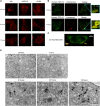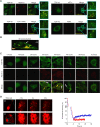A quantitative biology approach correlates neuronal toxicity with the largest inclusions of TDP-43
- PMID: 35895809
- PMCID: PMC9328675
- DOI: 10.1126/sciadv.abm6376
A quantitative biology approach correlates neuronal toxicity with the largest inclusions of TDP-43
Abstract
A number of neurodegenerative conditions are associated with the formation of cytosolic inclusions of TDP-43 within neurons. We expressed full-length TDP-43 in a motoneuron/neuroblastoma hybrid cell line (NSC-34) and exploited the high-resolution power of stimulated emission depletion microscopy to monitor the changes of nuclear and cytoplasmic TDP-43 levels and the formation of various size classes of cytoplasmic TDP-43 aggregates with time. Concomitantly, we monitored oxidative stress and mitochondrial impairment using the MitoSOX and MTT reduction assays, respectively. Using a quantitative biology approach, we attributed neuronal dysfunction associated with cytoplasmic deposition component to the formation of the largest inclusions, independently of stress granules. This is in contrast to other neurodegenerative diseases where toxicity is attributed to small oligomers. Using specific inhibitors, markers, and electron microscopy, the proteasome and autophagy were found to target mainly the largest deleterious inclusions, but their efficiency soon decreases without full recovery of neuronal viability.
Figures






Similar articles
-
Endoplasmic Reticulum Stress Signalling Induces Casein Kinase 1-Dependent Formation of Cytosolic TDP-43 Inclusions in Motor Neuron-Like Cells.Neurochem Res. 2020 Jun;45(6):1354-1364. doi: 10.1007/s11064-019-02832-2. Epub 2019 Jul 6. Neurochem Res. 2020. PMID: 31280399 Free PMC article.
-
Selective occurrence of TDP-43-immunoreactive inclusions in the lower motor neurons in Machado-Joseph disease.Acta Neuropathol. 2009 Oct;118(4):553-60. doi: 10.1007/s00401-009-0552-x. Epub 2009 Jun 13. Acta Neuropathol. 2009. PMID: 19526244
-
Low molecular weight species of TDP-43 generated by abnormal splicing form inclusions in amyotrophic lateral sclerosis and result in motor neuron death.Acta Neuropathol. 2015 Jul;130(1):49-61. doi: 10.1007/s00401-015-1412-5. Epub 2015 Mar 19. Acta Neuropathol. 2015. PMID: 25788357 Free PMC article.
-
The extreme N-terminus of TDP-43 mediates the cytoplasmic aggregation of TDP-43 and associated toxicity in vivo.Brain Res. 2016 Sep 15;1647:57-64. doi: 10.1016/j.brainres.2016.04.069. Epub 2016 May 4. Brain Res. 2016. PMID: 27155453 Free PMC article. Review.
-
Maintaining the balance of TDP-43, mitochondria, and autophagy: a promising therapeutic strategy for neurodegenerative diseases.Transl Neurodegener. 2020 Oct 30;9(1):40. doi: 10.1186/s40035-020-00219-w. Transl Neurodegener. 2020. PMID: 33126923 Free PMC article. Review.
Cited by
-
Emerging Trends in the Field of Inflammation and Proteinopathy in ALS/FTD Spectrum Disorder.Biomedicines. 2023 May 31;11(6):1599. doi: 10.3390/biomedicines11061599. Biomedicines. 2023. PMID: 37371694 Free PMC article. Review.
-
Empowering the NSC-34 cell line as a motor neuron model: Cytosine arabinoside's action.Neural Regen Res. 2026 Jan 1;21(1):357-364. doi: 10.4103/NRR.NRR-D-24-00034. Epub 2024 Sep 24. Neural Regen Res. 2026. PMID: 39314144 Free PMC article.
-
Targeting RACK1 to alleviate TDP-43 and FUS proteinopathy-mediated suppression of protein translation and neurodegeneration.Acta Neuropathol Commun. 2023 Dec 18;11(1):200. doi: 10.1186/s40478-023-01705-8. Acta Neuropathol Commun. 2023. PMID: 38111057 Free PMC article.
-
TDP-43 and NEAT long non-coding RNA: Roles in neurodegenerative disease.Front Cell Neurosci. 2022 Oct 26;16:954912. doi: 10.3389/fncel.2022.954912. eCollection 2022. Front Cell Neurosci. 2022. PMID: 36385948 Free PMC article. Review.
-
A Multi-functional Hybrid System Comprised of Polydopamine Nanobottles and Biological Effectors for Cartilage Repair.Small. 2024 Dec;20(50):e2405979. doi: 10.1002/smll.202405979. Epub 2024 Jul 30. Small. 2024. PMID: 39077937 Free PMC article.
References
-
- Arai T., Hasegawa M., Akiyama H., Ikeda K., Nonaka T., Mori H., Mann D., Tsuchiya K., Yoshida M., Hashizume Y., Oda T., TDP-43 is a component of ubiquitin-positive tau-negative inclusions in frontotemporal lobar degeneration and amyotrophic lateral sclerosis. Biochem. Biophys. Res. Commun. 351, 602–611 (2006). - PubMed
-
- Neumann M., Sampathu D. M., Kwong L. K., Truax A. C., Micsenyi M. C., Chou T. T., Bruce J., Schuck T., Grossman M., Clark C. M., McCluskey L. F., Miller B. L., Masliah E., Mackenzie I. R., Feldman H., Feiden W., Kretzschmar H. A., Trojanowski J. Q., Lee V. M. Y., Ubiquitinated TDP-43 in frontotemporal lobar degeneration and amyotrophic lateral sclerosis. Science 314, 130–133 (2006). - PubMed
-
- Mackenzie I. R., Bigio E. H., Ince P. G., Geser F., Neumann M., Cairns N. J., Kwong L. K., Forman M. S., Ravits J., Stewart H., Eisen A., McClusky L., Kretzschmar H. A., Monoranu C. M., Highley J. R., Kirby J., Siddique T., Shaw P. J., Lee V. M., Trojanowski J. Q., Pathological TDP-43 distinguishes sporadic amyotrophic lateral sclerosis from amyotrophic lateral sclerosis with SOD1 mutations. Ann. Neurol. 61, 427–434 (2007). - PubMed
-
- Brettschneider J., Del Tredici K., Toledo J. B., Robinson J. L., Irwin D. J., Grossman M., Suh E., Van Deerlin V. M., Wood E. M., Baek Y., Kwong L., Lee E. B., Elman L., McCluskey L., Fang L., Feldengut S., Ludolph A. C., Lee V. M., Braak H., Trojanowski J. Q., Stages of pTDP-43 pathology in amyotrophic lateral sclerosis. Ann. Neurol. 74, 20–38 (2013). - PMC - PubMed
-
- Hasegawa M., Arai T., Nonaka T., Kametani F., Yoshida M., Hashizume Y., Beach T. G., Buratti E., Baralle F., Morita M., Nakano I., Oda T., Tsuchiya K., Akiyama H., Phosphorylated TDP-43 in frontotemporal lobar degeneration and amyotrophic lateral sclerosis. Ann. Neurol. 64, 60–70 (2008). - PMC - PubMed
MeSH terms
Substances
LinkOut - more resources
Full Text Sources
Medical
Research Materials

